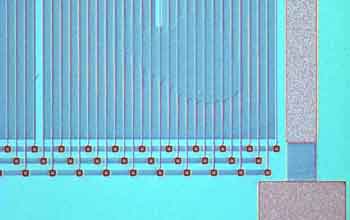Multimedia Gallery
This photo shows electrodes in a "pumping region" of the device.
Mechanical engineers at Purdue are developing a new type of computer cooling technology that uses a sort of nano-lightning to create tiny wind currents. This photo shows electrodes in a "pumping region" of the device. Clouds of ions created when electrons react with air are then attracted by these electrodes and "pumped" forward by changing the voltages in the electrodes. The researchers have demonstrated that the pumping concept works with a region of electrodes made of many series, each series containing three electrodes. The first in the series is the most positively charged, followed by an electrode that has a less-positive charge and then a third electrode that is negative. The voltages are rapidly switched from one electrode to the next in such a way that the clouds of ions move forward. The electrode voltages are switched roughly a million times a second, pushing the ion clouds forward and producing a cooling breeze.
Credit: Daniel J. Schlitz, Purdue School of Mechanical Engineering
Images credited to the National Science Foundation, a federal agency, are in the public domain. The images were created by employees of the United States Government as part of their official duties or prepared by contractors as "works for hire" for NSF. You may freely use NSF-credited images and, at your discretion, credit NSF with a "Courtesy: National Science Foundation" notation.
Additional information about general usage can be found in Conditions.
Also Available:
Download the high-resolution version of the image. ()
Use your mouse to right-click (Mac users may need to Ctrl-click) the link above and choose the option that will save the file or target to your computer.
Related story: A Tiny Wind to Cool the Tiniest Circuits



